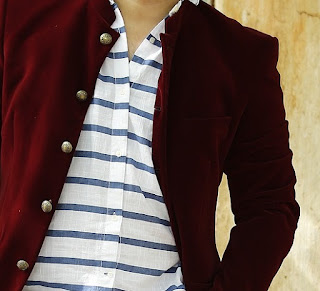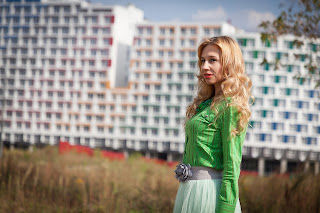1. Man's robe (agarkha) of silk and metal thread with applied ribbon and gold wrapped buttons, Pakistan (mid 19th century):
It is made of silk and gold fabric, lined with red and yellow silk. The distinctive circular opening combined with rectangular panel to cover the chest identifies this garment as an angarkha, which simply means the protector of the body. The upper part of rope is evidently it's focal point, and it is made more elaborate by the addition of a row of non function buttons around 1 side of the front opening. Like all roofs of this type this distinctive round neck and waist are fastened by silk ties- in this case in red blue and yellow- which are also used for the colourful piping around the neck and edges. It would have been paired with narrow trousers of silk and gold fabric.
Man Robe
of red wool couched with gold wrapped thread, India or Pakistan (mid 19th
century)
The distinctive side
fasting panel that passes over the chest of this young man's robe is typically
of a type of angarkha. The rope is unusual in that it is made of the fine
Kashmir wool with shawls. The intricate, spiraling pattern in couched gold
wrapped thread is typical of the work of Kaimur and Punjab, where this coat
would have been worn. It's lightly padded woollen material would have protected
the wearer from the severe winters off this Northern areas.
The brilliant green silk ties-are echoed in the neck facing and lining of the same material.
3. Women's jacket of
silk velvet embroidered with metal thread and trimmed with silk chiffon, Bosnia
and Herzegovina (1880)
Velvet jackets waistcoats and coats heavily embroidered with metal thread work part of formal dress in many areas of South eastern Europe and the near east from about 1830 onwards. There were enclosed by the use of old embroidery on military and diplomatic uniforms: the stiff, erect collar encrusted with gold and silver thread, which spills onto the front of this story jacket, has a distinct military bearing. The brightness of the silver is picked up by a delicate ruffle of pleated silk chiffon, which has been attached around the collar and front edges. It's tiny plits have a nice sharp crisis but the transparent silk is soft and light and falls into ripples of gossmer as it caresses the neck. It is totally feminine and very unusual in a garment of this type.
4. Women blouse of
cotton with linen, sleeves embroidered with wool (Norway (east talemark), mid
19th century 797-1884
The cool climate of Northern Europe makes it desirable to wear clothes that fit the body snugly at the wrist and neck in order to retain body heat. This high stand up collar was made from two thicknesses of cloth, embroidered with wool in small and closely packed cross stitch, creating a substantial fabric with a fair degree of rigidity. It would have been secured with a piece of silver jewellery inserted through the two loops. Not only would the wearers neck and shoulders have been kept warm, but the height of the collar would have required her to maintain her shoulders and head in an elegant , upright posture. It is difficult to achieve a sharp, crisp edge at the bottom of the neck slit, there is a tendency for the slit to widen into a curve. In order to disguise this and to reinforce the part most vulnerable to tearing, a few interlacing stitches have been worked with blue wool.
5. Women's jacket of
silk velvet, 1969
The short jacket was won by the donor with black trousers and the matching top. It's unusual colouring gives it a unique and special look. The turquoise material has cut velvet motifes scattered across it, with the Chinese character for long life matched across the front opening. The style of neckline on this jacket is sometimes perceived as being especially Chinese. Historic Chinese garments, however, do not invariably show this feature. Here the high collar around at the front is stiffened and the entire jacket is likely wadded to give it as a crisp appearance when worn. Hook and eye beneath the top top knot button secures the neck neatly. Plain velvet is used to bind the edges of the jacket and also to fashion the decorative froggings. These particularly strong components combine with the neckline to add to the garment's symmetry.
6. Women's dress of
cotton with silk panels and silk embroidery, Pakistan (mid 19th century)
The dark indigo blue cotton used for the main body of this dress and many others in Northwest Pakistan is locally woven and dyed. While some dresses are made up solely in this rather austere material others like this one are decorated, usually on the chest, with beautiful embroidered patterns, as well as with silk sils and other embellishments. The small triangular element that hangs from the waistband of this dress is probably derived from a traditional amulets, which protects the wearer and promises fertility. Such triangular amulets may be found in cloth or a metal and are seen widely specially on women's and children's dress throughout Afghanistan, Muslim Central Asia and much of Pakistan.
7. Girls jacket woven
silk, Korea , mid 20th century)
Yellow with red colour and bow, this multi colour jacket has striped sleeves in the five primary colors of blue yellow red white and green which can also be seen on the front of the jacket. As is customary with Korean jackets, the neckline is lined with the white border. Since this powder can easily be taken off and washed or simply replaced, the neckline can be kept clean without difficulty and the jacket has a longer life span. Here the border is made of the same material as the inner lining but contemporary mass produced ones are white. They are lined with paper in order to make them suitably stiff and durable. The red border have been decorated with an auspicious gold pattern of twenty petalled chrysanthemums, frequently seen on children's costumes. There are different ways in which gold is applied to Korean textiles. The unevenness of flowers suggests that here a "scatter gold" technique was used. The pattern is first carved into a wooden mould and their after covered with glue. The cloth is pressed into the mould, allowing the glue to seep through the material, and then gold powder is sprinkled over the wet glue
8. Women's tunic of
embroidered silk, China (19th or early 20th century)
The asmmetric neck and shoulder decoration on this women's tunic is composed of bands of patterned rate and gold silk from India. Each strip was carefully teased into an arc shape as it was sewn onto the tunic. The section forming the collar is evenly gathered. This effect inserting stiffness secured by rows of stitching. The configuration of this applied decoration denotes that the wearer was a married woman. There are no fastenings to this tunic, the inflexible nature of the ruched neck prevents it from falling open. The tunic came into the museum as part of a set with a magenta pink coat, green trousers, red waistcoat, scarlet leather leggings, a tasselled hat and silver and coral plait decorations. George Sheriff (1898-1967), the renowned plant hunter who donated them to the museum , recorded that he acquired them in khotan, a town in today's Xinjiang region of china.
9.Child's jacket of
embroidered silk:
The collar band is
beautifully shaped into a curl on the overlap section of this child jacket. The
embroidered white length of silk that forms the band is itself edged with
narrower strips of ice-blue, bias cut silk, which follow the curving outline.
Similar edgings are applied around the cuffs. The jacket is tailoring, although
similar to an adults robe, differs from a full size one in that the neckline
shape is straighter and has no knot buttons across it. The method of closure is
a tie at the side instead- throwback to earlier Chinese fastenings.
The margins of a garment are pale, the main part of the jacket is a strong red, the colour associated in China with joyous occasions. It was the custom to present a young child with Red and green clothes bearing good luck motifs. The gold crowned figure in the center depicts a male child bearing wishes for a son who will be successful in government high office. This jacket is part of complete sets as a reminder not to read the Chinese decorative repertoire of a European family, the parriams, for their baby daughter in Shandong province in North china in 1915.
10. Women's dress of
printed satin, China (1930-40)
Exceptionally high neck on this dress is one of the features that particularly marks out the 20th century Chinese garment style and known as the cheongsam or qipao. The neckband has stiff interlining to ensure it stands upright when the dress is worn. The black lace trim has been sewn all around the neck and this frames in the wearer's face. Black knot buttons and loops arranged in a trio high up across the collar opening further accentuate the neck and chin which would nestle into the space between the two sides of the neckband. Although attention might come to be focused on the wearer's head because of this concentrated decoration, the lace trim an import from Europe continuous along with collarbone closure down the side and across the hem and cuffs of the dress. This framing device harks back to the rules of trimming on women's gowns of an earlier period. While the trimming does not encourage much upon the main body of the garment it was strike a traditional note on a dress that is far from traditional it's revelation of the female shape. Athough the dress is full length it is tight fitting and has slits up the sides to reveal the legs.
Note:
Pictures are just used for representation. Actual dresses may vary.















0 Comments